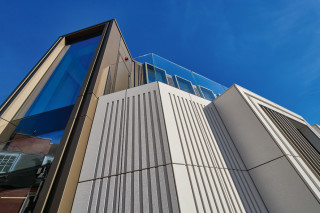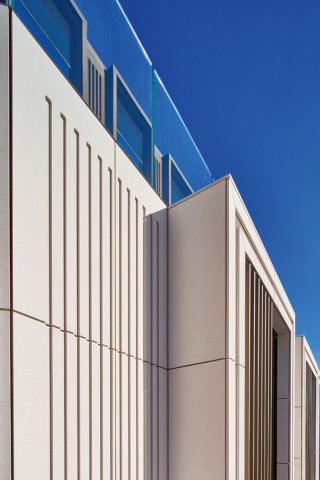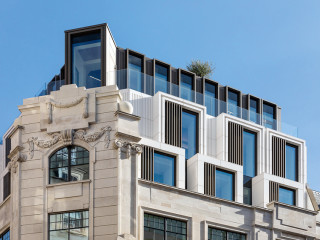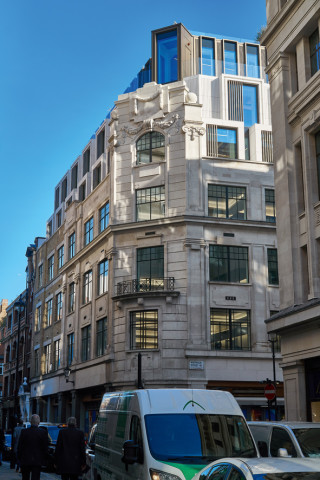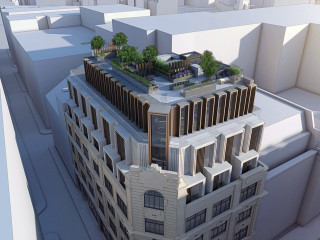The well-known mantra of the property business is ‘location, location, location’ and, when it comes to office accommodation, locations don’t come much more prestigious than that of Axtell House. Originally constructed in the 1920s, the office building boasts both original Art Deco features and a location in the west of Soho, a stone’s throw from Regent Street and the busy commercial area around Carnaby Street.
Like many London properties nearing their centenary, the building was in need of some updating. Internally the accommodation was from another era, not suited to contemporary working practices, and an historic addition of three new storeys on top of the original four-storey building was unsightly and no longer fit for purpose.
The job of designing a refurbishment scheme that would upgrade the accommodation while preserving the heritage appearance of its Art Deco past fell to London architect Darling Associates. The resulting project, delivered by Clerkenwell-based Red Construction, has seen the building transformed with stylish new interiors and replacement of the mid-20th century additions with three new storeys that both complement the original structure and increase the useable space within the building.
It was critical for the client, Estates & Agency Group, that the additional storeys created visual impact and gave the building a modern twist while complementing the existing facades.
Darling Associates, having decided it could achieve the desired result using a modern engineered stone cladding system, chose a product from the SureClad range of ventilated façades from manufacturer Shakerley, based in Chorley, Lancashire.
The SureClad panels were specified in a creamy beige colour to match the Portland stone of the original façades and sandblasted to create a textured finish. Some of the panels were also engraved using computer numerical control (CNC) equipment to create vertical linear fluting that replicates classical stone detailing.
Designer Guy Adams, of Darling Associates, explains: “Our intention was to connect the newly-constructed storeys to the existing building with a synergy of architectural form. In that way, the new additions will aid the local context of the building by positively contributing to the streetscape and referencing the materiality of both the original structure and surrounding buildings.
“The SureClad ventilated façade system and engineered stone panels enabled us to achieve a similar appearance to Portland stone without the structural loading, heavy masonry or cost implications of using the original material,” he adds.
“It offered us the design flexibility required to achieve both the aesthetic and buildability aims of the project and Shackerley’s in-house production capabilities meant that the details could be precision-manufactured and delivered to site as installation-ready elements.”
According to Adams, the design of the additional storeys that replace the previous extension is intended to integrate stone and metalwork into a contemporary mansard roof that resonates with the Art Deco aesthetic of the original building.
This design concept has been carried through to the interiors and also to new façade elements at lower levels, including feature entrances with the same Art Deco designs used in the lift lobbies and stairwells. The internal space has been reconfigured to allow direct access to the lift core for better accessibility.
Besides the new façade’s appearance, its thermal and environmental performance was also an important factor in the design, says Adams:

“It was important for us to consider the environmental implications of all materials specified to ensure that they met the sustainability aims of the project. Use of the ventilated façade system on the upper levels contributed to the thermal performance improvements achieved by the refurbishment and the SureClad engineered stone panels are not only in the Green Guide but have been fire tested and certified A2 in line with BS EN 13501-1,” he says.
The weight and strength of the engineered stone panels was a key consideration for the design team, since it was essential to minimise the structural loading of the new extension, which was larger than the previous additional storeys.
Adams explains: “We needed to create the impression of stone and the detailing that would carry through the Art Deco concept at levels four to six without incurring the need for strengthening the existing structure.”
The strength and versatility of the SureClad engineered stone meant that panels that were just 20mm and 30mm thick could be used to create the impression of natural stone at a fraction of the weight.
“And because engineered stone is weather-resistant and resistant to air-pollution, it will maintain its colour and high-end appearance over time too,” comments Adams.
Red Construction carried out a soft strip of the building and demolished the historic additions before constructing the new structure. The additional storeys are of lightweight steel frame construction and the cladding system was engineered by façade consultant FMDC to create the impression of a heavy stone façade without the associated weight.
Specialist installer Dmitro Facades was given the task of installing the façade for the new three-storey addition. The company, which has used the SureClad system on numerous previous projects, worked closely with Shackerley to ensure production schedules were aligned to the detailed façade plans and installation programme.
Mustafa Kurtumerov, contracts manager with Dmitro Facades, comments: “The design of the new elevations is quite complex, with curtain walling and anodised metallic cladding sitting alongside the SureClad panels, which meant there were a lot of interfaces between the different materials.
“Delivering the programme on time depended on the right details being available on site on a just in time basis, particularly for this site where storage and access were limited. Shackerley helped us to ensure that the whole installation ran like clockwork.”
All façade elements were custom-manufactured at Shackerley’s plant in Lancashire. CNC engraving was used to add linear fluting to the 30mm-thick engineered stone panels, with each groove cut to form a channel 35mm wide and 15mm deep to create total uniformity for the decorative finish, which is clearly visible from street level.
Shackerley also prefabricated a number of complex pre-assembled units to enable faster and easier installation on site. In total, more than 100 different types of panel and detail were specified, including panels of varying sizes, with the largest used on this scheme measuring 1,732mm x 925mm.
The system was installed using Shackerley’s SureClad ‘Hang On’ system, which allows the panels to be lifted into position on horizontal rails and provides full support while they are being levelled. Specially-designed brackets were fixed to the reverse side of each SureClad panel with stainless steel undercut anchors as part of the fabrication process.
Adjustment bolts in these brackets make manoeuvring each panel into the correct position on the façade quick and simple, says Kurtumerov: “Although the cladding installation covered a relatively small area, the complexity of the design, the mansard-style windows and the interface between different materials made this a potentially challenging installation.”
Axtell House has now been completed, bringing new cat A office accommodation to a prime London location. Thanks to the creative approach to façade specification, the upper storeys both reference a forward-focused, contemporary city and reflect its architectural heritage.
This article was first published in the June 2019 issue of The Construction Index magazine
UK readers can have their own copy of the magazine, in real paper, posted through their letterbox each month by taking out an annual subscription for just £50 a year. Click for details.
Got a story? Email news@theconstructionindex.co.uk


